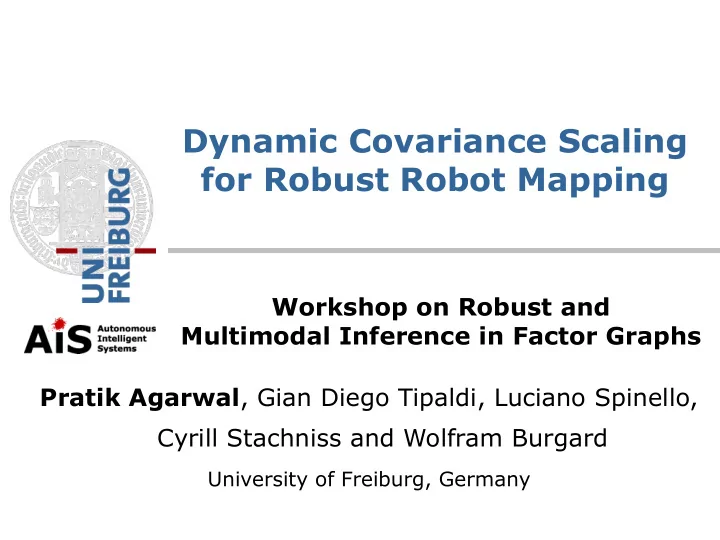

Dynamic Covariance Scaling for Robust Robot Mapping Workshop on Robust and Multimodal Inference in Factor Graphs Pratik Agarwal , Gian Diego Tipaldi, Luciano Spinello, Cyrill Stachniss and Wolfram Burgard University of Freiburg, Germany
Maps are Essential for Effective Navigation
Graph-based SLAM Robot pose Constraint
Graph-based SLAM Robot pose Constraint
Graph-based SLAM Robot pose Constraint Landmark
Graph-based SLAM Robot pose Constraint Landmark
Graph-based SLAM Robot pose Constraint a single outlier …
Graph-based SLAM Robot pose Constraint a single outlier …
Graph-based SLAM Vegas!! Robot pose Constraint Paris!! a single outlier …
Graph-based SLAM Robot pose Constraint a single outlier … ruins the map
Graph-SLAM Pipeline Front end Validation Back end Assumption: No Outliers Impossible to have perfect validation
SLAM Back End Fails in the Presence of Outliers 1 10 100 1 10 Outlier Outliers Outliers Outlier Outliers
SLAM Back End Depends on the Initial Guess Good Initial Guess
SLAM Back End Depends on the Initial Guess Good Initial Guess Bad Initial Guess
Typical Assumptions Gaussian assumption is violated Perceptual aliasing Measurement error Multipath GPS measurements
Typical Assumptions Gaussian assumption is violated Perceptual aliasing Measurement error Multipath GPS measurements Linear approximation is invalid Linearization is only valid if close to optimum
Typical Assumptions in Graph-SLAM No outliers Good initial guess Current methods both independently Our method approaches both problems
Typical Assumptions in Graph-SLAM No outliers Good initial guess Current methods solve both independently Our method approaches both problems Our Approach Dynamic Covariance Scaling
Our Approach: Dynamic Covariance Scaling Successfully rejects outliers More robust to bad initial guess Does not increase state space Is a robust M-estimator
Standard Gaussian Least Squares
Dynamic Covariance Scaling
How to Determine s?
How to Determine s? . . . Closed form approximation of Switchable Constraints with a M-estimator
Dynamic Covariance Scaling
Dynamic Covariance Scaling Both have squared error
Dynamic Covariance Scaling Original error Scaled error
Dynamic Covariance Scaling Linearization
Dynamic Covariance Scaling
Robust SLAM with Our Method Ground Initialization Gauss Our Truth Newton Method (1000 Outiers) Sphere2500 Manhattan3500 (1000 Outiers)
Dynamic Covariance Scaling with Front-end Outliers Bicocca multisession dataset
Dynamic Covariance Scaling with Front-end Outliers Lincoln-labs multisession dataset
Robust SLAM with Our Method Dynamic Covariance Scaling Standard Victoria Park Gauss- Initialization Newton (Odometry)
Robust SLAM with Our Method Dynamic Covariance Scaling Standard Gauss- Newton
Robust SLAM with Our Method Dynamic Covariance Scaling Standard Gauss- Newton
Dynamic Covariance Scaling with Outliers in Victoria Park RPE #Outliers DCS recovers correct solution GN fails to converge to the correct solution even for outlier-free case
Robust Visual SLAM with Our Method 3D grid worlds of different sizes Robot perceives point landmarks
Robust Visual SLAM with Our Method ~1000 camera poses ~5000 camera poses ~4000 features ~5000 features ~20K constraints ~100K constraints
Robust Visual SLAM with DCS Ground Initialization Truth (Odometry) (Bad initial guess) Simulated Stereo Our Method Levenberg-Marquardt (100 iterations) (15 iterations)
Robust Visual SLAM with DCS Ground Initialization Truth (Odometry) (Bad initial guess) Simulated Stereo Our Method Levenberg-Marquardt (150 iterations) (15 iterations)
Robust Visual SLAM with DCS DCS recovers correct solution in the presence of up to 25% outliers LM fails to converge to the correct solution even for outlier-free cases
Convergence – 1000 Outliers Switchable Constraints Dynamic Covariance Scaling Sphere2500 Manhattan3500 Iterations
Convergence – 1000 Outliers Switchable Constraints Dynamic Covariance Scaling Sphere2500 Manhattan3500 RPE Iterations
Convergence with Outliers Dynamic Switchable Covariance Constraints Scaling
Conclusion Rejects outliers for 2D & 3D SLAM No increase in computational complexity More robust to bad initial guess Now integrated in g2o
Thank you for your attention!
Recommend
More recommend